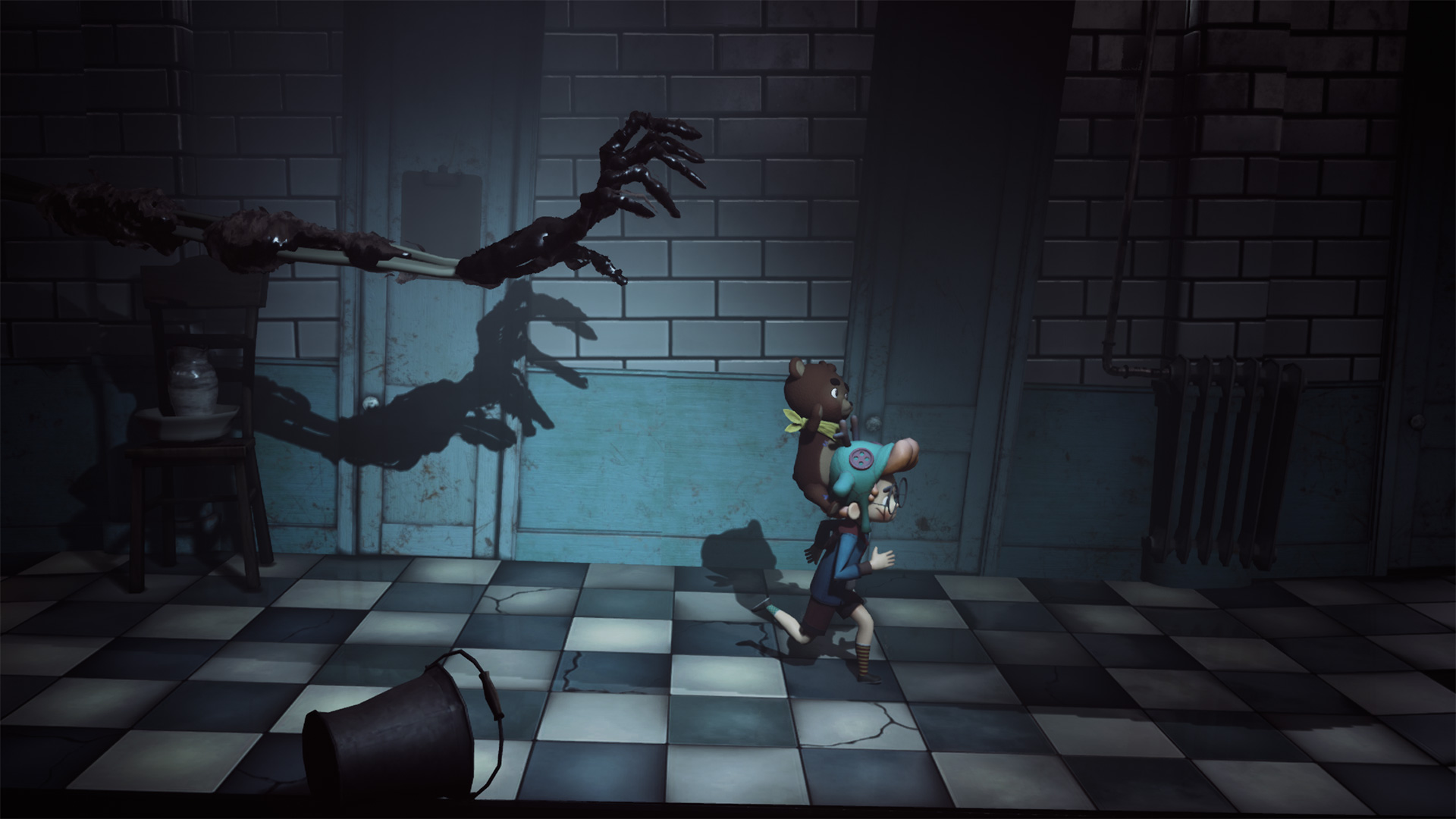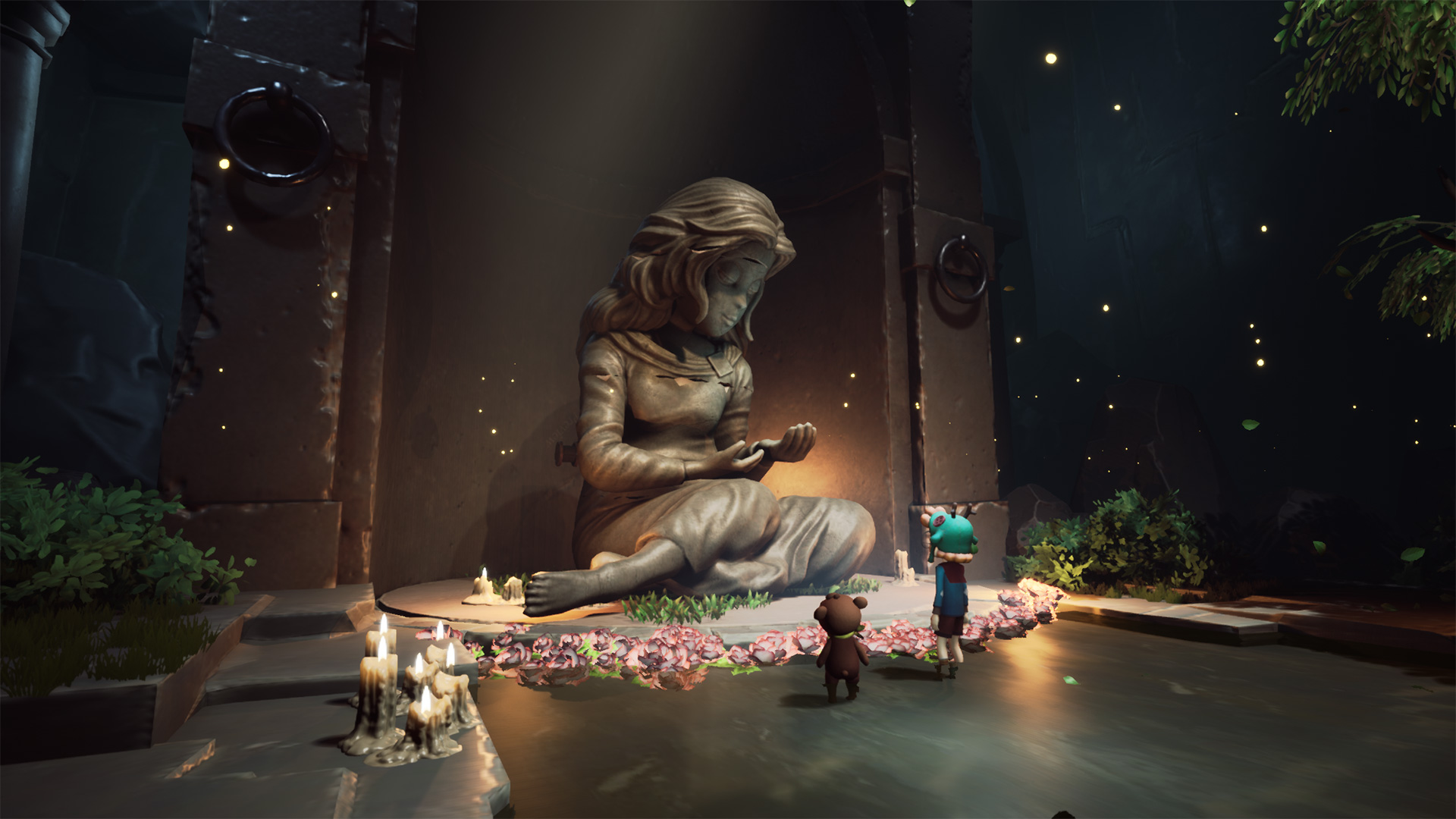Daydream: Forgotten Sorrow is an atmospheric adventure game that follows the tale of Griffin and his favourite teddy bear Birly. They explore a strange world together evading monsters and solving mysteries. The thing is, other than the title, you’re not actually shown any introduction to the story. Griffin wakes up and finds himself being chased by a big scary hand down a corridor. That is it. That’s your opener.
Drifting Off
If you read other generic descriptions of Daydream it will tell you that you are fighting against Griffin’s fears. I mean, I’m not exactly certain I would be thrilled with the idea of a giant hand chasing me either but okay. It’s a shame because with any game, unless there is context I can find myself massively disconnected from the get-go.
Daydream: Forgotten Sorrow does have the odd cutscene, to depict a scary spider that misses its entrance to capture you, or you riding through to your next adventure; jumping right in is completely fine, but eventually it feels like your story has to answer some questions. Why are we here? And if we don’t know why, why is it so important we escape the lovely meadows or the paper plane I was flying? If I don’t know, I just don’t care.
Can I appreciate other elements of the game? Sure, I’m not a complete animal. Let’s dive into the positives of Daydream: Forgotten Sorrow before I tell you about how often I daydreamed myself whilst playing. One thing I did really appreciate was the different story settings. The game is done in 11 chapters, (maybe 12, I didn’t get that far – more on that later) and each chapter denotes a different theme or setting. From sunny meadows to castles and windmills, to the circus (sort of). There is a lot of variety to explore.

Scratching the Surface
The art style is also very sweet to look at, at times. This visual design almost emanates a type of game that you would think is flawless. Birly, although helpful in getting you through your adventure, is always very adorable in movements. The picture in front of you offers a cartoon-like fantasy world that is almost endearing until you get to the depths of the forest when spiders approach. You can see that inspiration has been taken from popular games such as Little Nightmares but misses the mark when it comes to tension due to its heavy-handed controls and frustrating mechanics.
I found myself mostly getting frustrated, even quite uninterested throughout. There are glimmers of enjoyment until it felt like bad handling and horrible depth perception ruined the experience for me altogether. There’s one particular moment where I thought to myself “that’s more like it!”, but it took a few chapters to get there. In this particular part of your adventure you’re riding a bicycle that has transformed into a plane, taking in the views of beautiful waterfalls and lakes below, ducking and diving into hidden caves. Even then, dodgy handling and rigid steering soured my experience. The controller would vibrate as if the plane was about to crash, but the bad controls made it impossible to correct whatever was about to go awry.
It’s a shame really because I feel Daydream: Forgotten Sorrow had potential. The pace of the whole game feels incredibly on and off. There are times when the flow and pace feel naturalistic and you feel a rhythm, but then all of a sudden you’re met with a puzzle that will require your attention for longer than it really needs to have been completed. The stop-start flow of the game had me just wanting to get on with it.
A Nightmare Dressed Like a Daydream

For the first few chapters, everything feels predictable and the puzzles are extremely simple. That is fine, I can get on board with that – it helps set up the mechanics I’ll be taking with me moving forward. However, the main thing getting in the way is the wildly infuriating depth perception and platforming mechanics that make Griffin constantly fall off due to the 2.5D camera perspective. If Griffin should fall from a height, he will die meaning you go back to your checkpoints. Checkpoints are not usually that long, but the puzzles can have multiple elements to them, so constantly starting them over can be a pain.
There were times where I would jump to grab ledges and Griffin would clip right through the edge of it and fall to his death. Once or twice is fine, three or four times is a pattern and more than five overall is just down-right annoying. This is essentially what led me to stop the game in its tracks at around chapter 7. I couldn’t bear (pun intended) to do the same jump again for it to clip through or for him not make it when he made it two jumps ago but fell off for another unbeknownst reason, or Birly got stuck and I had to force restart. If I restarted in the same place I fell, fine, but restarting a whole mini section I just don’t care to do if the obstacles, environment and mechanics are not going to do it’s one job.
Stealth sections like moving through a nest of spider eggs, nearly became nigh-on ridiculous because what would kill you in one run, wouldn’t kill you in the next. Where you were super careful on one run and set off all the eggs, it made no sense when you would run through and set off one or two. I did enjoy some of the gameplay aspects here. Luring spiders into traps so you can progress and escaping a good ol’ chase scene is always a satisfying win.
Alone In The Dark

Whilst some puzzle elements were fun and sensical to complete. Others just seemed laborious. In one section, after a cut scene that follows you running from a corridor collapsing on itself you meet a room with deer heads in a library. The scene almost acts as if this is a brand new chapter with Griffin opening the big library door to enter his next segment of action. I spent far longer than I should have looking for the missing piece, for it to only be in the area before the big cut scene. This, for me, is where the pace just felt off.
Birly is your assisting character, and he can help you get through windows, assist in pulling levers, or just all around open a door from another side by scooting through a small hole. You have the ability to be able to command Birly in certain areas and he will follow that command. Well, you hope anyway. Sometimes clicking on the command just led him to be a disobedient bear, and he would just stand there. Sometimes he would even get stuck in the environment and I would have to force reset the checkpoint.
In one particular late-game portion, my assisting character who was not Birly at this time, and who was very much an integral part of progressing to my next ledge, just flat-out disappeared. Nowhere to be seen, just absolutely peaced out of the game. How am I supposed to complete the level when even the supporting actors just go for lunch halfway through their scene?
Like I said, this is a shame because Daydream: Forgotten Sorrow feels unfinished, unpolished and un-refined. Visually it looks lovely, there are good ‘story elements’ despite there being a lack of overarching story, and there’s variety in the environment. However, the gameplay mechanics, controls and depth perception issues make this experience feel more like a nightmare than daydream.
Whilst visually appealing, Daydream: Forgotten Sorrow has infuriating depth perception, technical issues and a story that doesn’t offer much engagement to see you through the end. There is a good game in there somewhere, but at present Daydream: Forgotten Sorrow unfortunately feels unfinished, unpolished and unrefined.

Daydream: Forgotten Sorrow is available June 14th on PC via Steam (review platform) and Epic Games Store.
Developer: Frozen Line
Publisher: Ravenage Games
Disclaimer: In order to complete this review, we were provided with a promotional copy of the game. For our full review policy, please go here.
If you enjoyed this article or any more of our content, please consider our Patreon.
Make sure to follow Finger Guns on our social channels –Twitter, Facebook, Twitch, Spotify or Apple Podcasts – to keep up to date on our news, reviews and features
